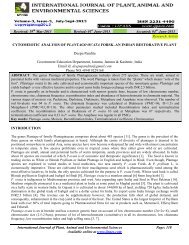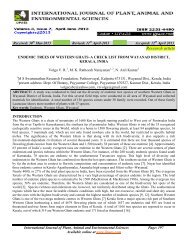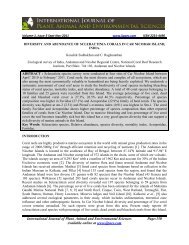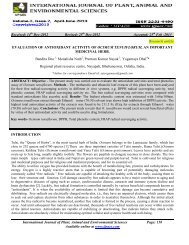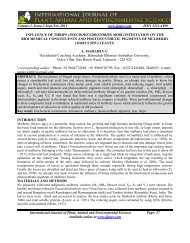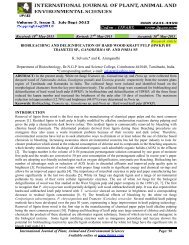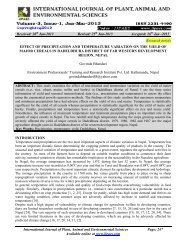THE EFFECTS OF PALM OIL ON THE PHYSICAL ... - Ijpaes.com
THE EFFECTS OF PALM OIL ON THE PHYSICAL ... - Ijpaes.com
THE EFFECTS OF PALM OIL ON THE PHYSICAL ... - Ijpaes.com
You also want an ePaper? Increase the reach of your titles
YUMPU automatically turns print PDFs into web optimized ePapers that Google loves.
Received: 17 th August-2012 Revised: 20 th August -2012 Accepted: 24 th August -2012Research article<strong>THE</strong> <strong>EFFECTS</strong> <strong>OF</strong> <strong>PALM</strong> <strong>OIL</strong> <strong>ON</strong> <strong>THE</strong> <strong>PHYSICAL</strong> APPEARANCE <strong>OF</strong> Clarias gariepinusDURING TRANSPORTATI<strong>ON</strong>E. FALAYE 1 , A. OMOIKE 2* , FOLORUNSO L. A. 1 & O. S. BELLO 11 Department of Wildlife & Fisheries Management, University of Ibadan, Ibadan, Nigeria.2 Department of Biological Sciences, Bells University of Technology, Ota, Nigeria.*Corresponding author email:dromoike@yahoo.<strong>com</strong>ABSTRACT:The study on the rate of water quality deterioration, bacterial load, survival percentage and physicalappearance of transported adult Clarias gariepinus was carried out using palm oil as water additive and anti-stress atdifferent concentrations, 904mgL -1 ,1808 mgL -1 and 2712 mgL -1 and <strong>com</strong>pared to salt at 0.4% over a six hourtransportation period. The adult fish were transported in a container at 2kg /litre of water in an open van while thewater samples were at zero, second, fourth and sixth hours of transportation. Water quality, physical appearance andthe survival rate of the fish within the various treatments were assessed at the end of the transportation exercise.The pH of transport water containing oil at 904mgL -1 , 1808mgL -1 and 2712mgL -1 was maintained during the courseof transportation in contrast to the treatment containing 0.4% salt and the control whose pH changed at the secondhour of transportation but the dissolved oxygen (DO), temperature, ammonium (NH 4 ), Nitrate (NO 3 ), Nitrite (NO 2 )and chlorine (CI) of all the treatments followed the same trend while the bicarbonate (HCO 3 ) concentration oftransport water containing 2712mgL -1 palm oil were maintained till the second hour before it changed at the fourthand sixth hours of transportation. The plate count agar (PCA) of all the treatments containing oil recorded moreorganisms than the treatment containing 0.4% salt and the control; but, the fish in all the treatments containing palmoil have an appearance not different from when freshly harvested in contrast to the control that had bruises and scarson the skin and the survival percentage of fish in all the treatments was between 95% - 100%. It has been revealedthat addition of palm oil at the varying concentrations kept the freshness of the fish during transportation therebyimproving the market value of transported live catfish.Key words: Dissolved Oxygen, pH, fish survival, physical appearance, market value transportationINTRODUCTI<strong>ON</strong>Harvesting, holding and transporting of market sized fish is a particularly important aspect of fish farming becausethe producer is dealing with his ultimate saleable product. However this phase of fish farming is frequentlyoverlooked during the production management process (Dupree and Hurner, 1984), but the transportation of live fishis particularly important in aquaculture (Gupta and Gupta, 2006) The goal of fish transportation is to provide at thedestination only healthy fish that will live and satisfy the criteria of the transporter but transportation of live fishinvolves the moving of large numbers or weights of fish in a small place (Dupree and Hurner, 1984) and the volumeof water within the transport container is small relative to the mass of the fish thus the fish are subjected to stress(Crosby et al., 2006)Fish are easily stressed by handling, transport and stress resulting to immuno-suppression, physical injury or evendeath (Crosby et al., 2006). The major concerns in transporting aquatic animals are the management of handlingstress, mechanical shock, heat stress and water quality (Coyle et al., 2004). Some water quality parameters of utmostimportance during transportation include dissolved oxygen levels, changes in temperature, pH, carbon dioxide,ammonia and the salt balance of the fish’s blood (Swann, 1993, Crosby et al., 2006). Numerous chemicaladditives/anaesthetic can be added to the transport water to alleviate several problems associated with transportingfish (Swann, 1993), the reduction in these stress factors during transportation lowers mortality and improvesappearance (Crosby et al., 2006).International Journal of Plant, Animal and Environmental Sciences Page: 82Available online at www.ijpaes.<strong>com</strong>
Omoike et al Copyrights@2012 IJPAES ISSN 2231-4490MATERIALS AND METHODSSource of Fish. Adult catfish of average weight 550g were obtained from a <strong>com</strong>mercial fish farm of known integrityin Ibadan, Oyo state, NigeriaSource of Water. The water used was from a dug well located at Amzat Agro Allied Enterprises (IBZ-026308) farm<strong>com</strong>plex, Ibadan and it was passed through series of cascades to aerate it, the aerated well water was later used tohold the fish for 15 minutes before the actual experiment started.Loading of Fish. The fish was loaded at 2kg/litre of water in 35litre containers (20kg of fish was weighed into 35litre plastic bowls containing 10 litres of water each). The top of the bowls was covered with a woven sack fasten tothe bow’s side to allow exchange of air as shown in plate 1.Plate 1: Vehicle showing the fish being transported in bowls.Preparation of Treatment. The additive tested was palm oil and it was added at the following rates 2.5ml, 5.0ml and7.5ml per litre of transport water. Non iodized salt was added at 4parts per thousand (ppt) to another treatment for<strong>com</strong>parisons and the fifth treatment did not have any additive so that it could serve as control.Concentration of the TreatmentsTreatment 1: Control (No additive)Treatment 2: 4 grammes of non iodized salt was added per litre of waterConcentration = Mass of soluteVolume of solvent= 4 X 100%1000= 0.004= 0.4% = 4ppt = 4000ppmTreatment 3. An empty plastic syringe was used to weigh palm oil using 100grams capacity mini scalemodel HL-100, manufactured by A & D Company, Ltd. Korea. Care was taken to make sure air wasexpelled from the syringe before it was weighed.International Journal of Plant, Animal and Environmental Sciences Page: 83Available online at www.ijpaes.<strong>com</strong>
Omoike et al Copyrights@2012 IJPAES ISSN 2231-4490Average weight of syringe + 2.5mls of palm oil 6.54gAverage weight of empty syringe 4.28gWeight of oil = 2.26g2.5mls of oil weigh 2.26gWeight of solute = 2.26gVolume of solute= 2.5ml:. Concentration = weight of solutevolume of solute= 2.262.5= 0.904gramsConcentration/Litre of water = 904mgL -1i.e 904mg of palm oil per litre of water.Treatment 4. 5.0mls of palm oil per litre of water was usedSince 2.5mls …………………………. 904mgL -1:. 5mls ………………………… 904 x 52.5= 1808mgL -1Treatment 5. 7.5mls of palm oil per litre of water was usedSince 2.5mls ……………………….. 904mgL -1:. 7.5mls ………………………. 904 x 7.52.5= 2712mgL -1Thus the treatment concentrations areTreatment 1 – No additiveTreatment 2 – 0.4% salt solutionTreatment 3 – 904mgL -1 of palm oilTreatment 4 – 1808mgL -1 of palm oilTreatment 5 – 2712mgL -1 of palm oilAll the treatments were replicated thrice to give a total of fifteen replicates.Collection of water sample for physico-chemical analysis. The temperature and pH of water samples was measuredusing a hand held pH meter (HANNA instruments, model no HI 98129- HI 98130). The water samples werecollected into 500mls bottles and the dissolved oxygen was determined by azide – modification to winklers methodof pond water analysis (Boyd, 1981) ammonium and nitrite was determined by distillation, nitrate was by brucinecolorimetric method while chloride and bicarbonate was by volumetric method as described by Udo and Ogunwale(1986).Collection of water samples for microbial analysis. Sample bottles that have been washed and autoclaved were usedto collect the water samples before loading of the fish, two(2), four (4) and six(6) hours of transportation. Adisposable glove was worn during the collection of the water samples to prevent contamination by hand andcontamination from one experimental unit to the other. The isolation of bacteria was done using the pour platemethod and Eosine methylene blue agar (EMB), MacConkey Agar (Mc) and Salmonella shigella agar (SSA) wereused at three different dilutions i.e 10 -2 ,10 -4 and 10 -6 colony forming unit per milliliter (cfu/ml) for coliformidentification while the plate count agar (PCA) was used for total count .Assessment of Physical appearance of Fish after transportation. A quality index method (QIM) of fish qualitymeasurement (Huss, 1995) was adapted for assessing the physical appearance of the fish, the reason for adaptingQIM was because of inaccessibility to literatures on assessment of live fish but abundance of literature on assessmentof dead fish. At the expiration of six hours transportation period, two samples of fish were selected from eachcontainer to give a total of six fish per treatment for the QIM score and the scores were then recorded.Survival of Fish (%) calculation.International Journal of Plant, Animal and Environmental Sciences Page: 84Available online at www.ijpaes.<strong>com</strong>
Omoike et al Copyrights@2012 IJPAES ISSN 2231-4490SR= Number of fish after transportation X 100Number of fish before transportationStatistical Analysis. Complete randomization was used in designing the experiment and data resulting from theexperiment were analyzed using descriptive statistics.RESULTSThe trend of changes in water quality parameters of the transported fish is presented in figures 1-8 while the totalcount of organisms observed on plate count agar (PCA) at three (3) different dilutions is presented in figure 9. Thequality index method QIM was adapted to assess the physical appearance of the fish after transportation and ispresented in figure 10 while the survival percentage of the fish after transportation is presented in figure 11.7DISSOLVED OXYGEN mg/L65432100 2 4 6Control0.4% salt904mg/L oil1808mg/L oil2712mg/L oilTIME (HOURS)Fig1: Dissolved Oxygen content of water used in transporting live Clarias gariepinus3530TEMP OC252015105Control0.4% salt904mg/L oil1808mg/L oil2712mg/L oil00 2 4 6TIME (HOURS)Fig.2: Temperature of water used in transporting live Clarias gariepinus120NH4 mg/L10080604020Control0.4% salt904mg/L oil1808mg/L oil2712mg/L oil00 2 4 6TIME (HOURS)Fig.3: NH 4 content of water used in transporting live Clarias gariepinusInternational Journal of Plant, Animal and Environmental Sciences Page: 85Available online at www.ijpaes.<strong>com</strong>
Omoike et al Copyrights@2012 IJPAES ISSN 2231-449060NO3 mg/L5040302010Control0.4% salt904mg/L oil1808mg/L oil2712mg/L oil00 2 4 6TIME (HOURS)Fig.4: NO 3 content of water used in transporting live Clarias gariepinus60NO2 mg/L5040302010Control0.4% salt904mg/L oil1808mg/L oil2712mg/L oil00 2 4 6TIME (HOURS)Fig.5: NO 2 content of water used in transporting live Clarias gariepinus120HCO3 mg/L10080604020Control0.4% salt904mg/L oil1808mg/L oil2712mg/L oil00 2 4 6TIME (HOURS)Fig.6: HCO 3 content of water used in transporting live Clarias gariepinusCHLORIDE mg/L1008060402000 2 4 6Control0.4% salt904mg/L oil1808mg/L oil2712mg/L oilTIME (HOURS)Fig.7: Chloride content of water used in transporting live Clarias gariepinusInternational Journal of Plant, Animal and Environmental Sciences Page: 86Available online at www.ijpaes.<strong>com</strong>
Omoike et al Copyrights@2012 IJPAES ISSN 2231-44907pH6.86.66.46.26Control0.4% salt904mg/L oil1808mg/L oil2712mg/L oil5.80 2 4 6TIME (HOURS)Fig.8: pH of water used in transporting live Clarias gariepinusPOPULATI<strong>ON</strong> <strong>OF</strong> ORGANISMS(cfu/ml)350300250200150100500PCA 10-2 PCA 10-4 PCA 10-6C<strong>ON</strong>TROL0.4% SALT904mg/L oil1808mg/L oil2712mg/L oilTOTAL COUNT <strong>OF</strong> ORGANISMS ATDIFFERENT DILUTI<strong>ON</strong> RATESFig. 9: Plate Count Agar (PCA) of the water used in transporting live Clarias gariepinus after sixhours transportation period.QIM VALUE10.90.80.70.60.50.40.30.20.10TRT 1 TRT 2 TRT 3 TRT 4 TRT 5TREATMENTSFig.10: Adapted Quality Index Method (QIM) scale showing the physical appearance of Clarias gariepinusafter six hours transportation exercise.NB: The lower the value, the better the appearance of the fishSURVIVAL %1011009998979695949392TRT 1 TRT 2 TRT 3 TRT 4 TRT 5TREATMENTSFig. 11: Survival percentage of Clarias gariepinus after transporting for six hoursInternational Journal of Plant, Animal and Environmental Sciences Page: 87Available online at www.ijpaes.<strong>com</strong>
Omoike et al Copyrights@2012 IJPAES ISSN 2231-4490DISCUSSI<strong>ON</strong>The results obtained from water quality parameters in this study is in accord with the works of Crosby et al., (2006)who reported that as the duration of transportation increases, the dissolved oxygen content of the water decreases andalso reported that addition of salt aids osmoregulation and that dissolved oxygen concentration in the transportcontainer changes greatly during transport of fish. The transport water containing 0.4% salt had the highest dissolvedoxygen throughout the transport exercise while the transport water containing 2712mgL -1 oil had the least dissolvedoxygen till the end of transportation. The differing rates of oxygen depletion can be adduced to difference inphysiological states of the fish kept in different anaesthetic media (Crosby et al., 2006) but in this case, palm oil.The temperature of all different transport media followed the same trend increasing with duration of transport. TheAmmonium (NH 4 ), Nitrate (NO 3 ) and Nitrite (NO 2 ) content of the transport water increased with duration oftransportation and this is in agreement with the reports of Wedemeyer and Yasutake (1977) and Crosby et al.,(2006). Treatment containing 904mgL -1 of palm oil had the highest concentration of NH 4 at six hrs while 0.4% salthad the lowest concentration of NH 4 at six hours of transportation. The transport medium containing 2712mgL -1 ofpalm oil had the highest nitrate (NO 3 ) concentration throughout the transport period while the medium with 0.4% salthad the least concentration of nitrate during the period of transportation. Nitrite concentration of the transportmedium containing 2712mgL -1 of palm oil was highest during the period of transportation while the nitriteconcentration of the medium with 0.4% salt had the least concentration of nitrite during the period of transportation.The bicarbonate (HCO 3 ) content of the transport medium containing 0.4% salt had the highest rate of increasefollowed by that containing 904mgL -1 of palm oil while the transport medium with no additive (i.e control) had thelowest rate of increase in bicarbonate. The chloride content of the transport medium with 0.4% salt increased sharplyat the <strong>com</strong>mencement of the exercise due to the addition of salt to the medium and the rate of chloride concentrationincrease was followed by the medium with no additive (i.e. control) but all the treatments containing palm oilshowed a slower rate of increase in chloride concentration. The pH values of the transport medium containing noadditive and 0.4% salt increased sharply from the beginning of the transportation exercise till the second hour whenit stabilized till the sixth hour whereas there was no significant difference in the pH values of the all transport watercontaining palm oil from the <strong>com</strong>mencement of transportation till end of a transportation. This is contrary to Crosbyet al., (2006) that reported a decrease in pH of water during transportation of fish which was adduced to increase inCO 2 Production.The coliform count of water before transportation showed that the water is free of coliforms but the water samplescollected during the fish transportation for two, four and six hours showed that treatments containing palm oilrecorded more coliforms than the control and the treatment containing 0.4% salt. The presence of coliforms may befrom the transport containers and from the body of the fish, vomited feed and feaces. The organisms identified in allthe different agar are similar and they include coliforms, Enterobacter, Eschericha coli, shigella and salmonella. Theplate count agar (PCA) done to ascertain the total count also had the treatments containing palm oil having thehighest population of organisms at the different dilutions 10 -2 , 10 -4 and 10 -6 . The organisms identified on the PCAare basically Bacillus sp.The treatments containing palm oil have a QIM score of zero, while treatment containing 0.4% salt have a QIMvalue greater than 0.3 with the control (no additive) having a QIM score of (0.9 -1). It is worthy to note that thelower the QIM score the better the appearance of the fish and vice versa. Thus, fish in all the treatments containingpalm oil had a better physical appearance than the control and treatment containing 0.4% salt. This is in agreementwith Iwu (1993) who reported that palm oil is administered as poison antedote and used externally as lotion for skindiseases.The survival rate of fish in all the treatments was very high, indicating that application of palm oil in water used fortransporting catfish does not have a negative effect on fish survival.C<strong>ON</strong>CLUSI<strong>ON</strong>In conclusion, this study has shown that application of palm oil at 904mgL -1 , 1808mgL -1 and 2712mgL -1 to waterused in transporting live catfish showed a similar trend with no significant difference in water quality parameters butin terms of cost and quantity used, it is advisable to use 904mgL -1 , for transporting live catfish because it maintainsthe water pH, fish appearance and does not have a negative effect on fish survival. Thus, the knowledge of theminimum concentration of palm oil to be added to transport water for transporting live adult catfish will go a longway in reducing fish loss between the farm and the market as well as to <strong>com</strong>mand a higher market value andconsumer preference; hence, it has a corresponding increase in the in<strong>com</strong>e and profit that will be accrued to thefarmer.International Journal of Plant, Animal and Environmental Sciences Page: 88Available online at www.ijpaes.<strong>com</strong>
Omoike et al Copyrights@2012 IJPAES ISSN 2231-4490ACKNOWLEDGEMENTSThe authors give special thanks to Prince Bimbola Makanjuola, the chairman of Amzat Agro Allied Enterprises,Ibadan, Nigeria (IBZ-026308) who provided 300kg of live catfish used for this study and also gave out the fueledvehicle that was used.REFERENCESBoyd C.E. 1981. Water quality in warm water fish ponds. Auburn University Agricultural Experiment Station. (2 ndEdition) 359p.Coyle S.D, Durborow R.M and J.H. Jidwell, 2004. Anesthetics in Aquaculture. Southern Regional Aquaculture Centre.Publication no 3900Crosby T.C, Hill J.E, Martinez C.V, Watson C.A and R.P.E. Yanong, 2006. On-farm transport of Ornamental fish. (FA– 119) University of Florida IFAS Extension http://edis.ifas.uf/.edu.Dupree H.K. and J.V. Hurner, 1984. Transportation of live fish. Page 165-176 in H.K. Dupree and V.Hurner, (ed)Third report to fish farmers. U.S. fish and wildlife services, Washington, D.C.Gupta S.K and P.C. Gupta. 2006. Pure and Applied Ichthyology. Chand co Ltd, 1133pHurner J.V, Dupree H.K andD.C. Greenland, 1984. Harvesting, Grading and Holding fish pages158-164 in H.K Dupee and J.V. Huner (eds). Third report to fish farmers U.S. fish and Wildlife service, washington,D.C.Huss H.H.1995. Quality and quality changes in fresh fish. FAO Fisheries technical paper 348. Rome.Iwu, M.M. 1993.Handbook of African Medicinal Plants. CRC Press.LLCSwann, L.1993. Transportation of fish in Bags. North Central Regional Aquaculture Centre also in University ofMissouri Extension Live and Learn MX 392.Udo E.J & J.A. Ogunwale, 1986. Laboratory manual for soil, plant and water samples. 2 nd Edition. 174pp.Wedemeyer G.A and W.T. Yasutake, 1977. Clinical methods for the assessment of the effects of environmental stresson fish health. Technical papers of the US fish and wildlife service no 89. Washington, DC, US Dept of the Interior,Fish and Wildlife service.180p.International Journal of Plant, Animal and Environmental Sciences Page: 89Available online at www.ijpaes.<strong>com</strong>



